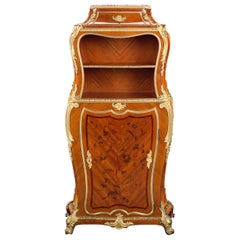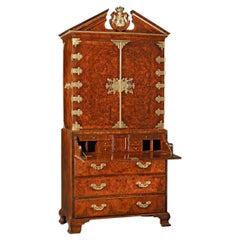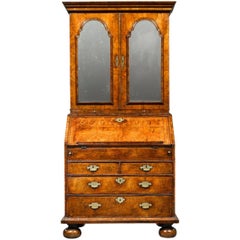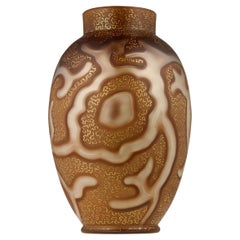Want more images or videos?
Request additional images or videos from the seller
1 of 4
Secrétaire à Abattant by Molitor
$94,850List Price
About the Item
- Creator:Christian Dell (Designer)
- Dimensions:Height: 57 in (144.78 cm)Width: 40.25 in (102.24 cm)Depth: 18 in (45.72 cm)
- Materials and Techniques:
- Place of Origin:
- Period:
- Date of Manufacture:18th Century
- Condition:
- Seller Location:New Orleans, LA
- Reference Number:Seller: 29-03951stDibs: U1209068911284
About the Seller
5.0
Recognized Seller
These prestigious sellers are industry leaders and represent the highest echelon for item quality and design.
Established in 1912
1stDibs seller since 2010
112 sales on 1stDibs
Typical response time: 8 hours
Authenticity Guarantee
In the unlikely event there’s an issue with an item’s authenticity, contact us within 1 year for a full refund. DetailsMoney-Back Guarantee
If your item is not as described, is damaged in transit, or does not arrive, contact us within 7 days for a full refund. Details24-Hour Cancellation
You have a 24-hour grace period in which to reconsider your purchase, with no questions asked.Vetted Professional Sellers
Our world-class sellers must adhere to strict standards for service and quality, maintaining the integrity of our listings.Price-Match Guarantee
If you find that a seller listed the same item for a lower price elsewhere, we’ll match it.Trusted Global Delivery
Our best-in-class carrier network provides specialized shipping options worldwide, including custom delivery.You May Also Like
French Empire Secrétaire á Abattant
Located in Baton Rouge, LA
A handsome 19th century French Empire secrétaire à abattant made of richly figured, bookmatched walnut. This desk has a black fossil marble top resting above a hidden drawer, free of hardware and opening by a shallow groove on the bottom of the drawer front. Below is a fold-front door revealing a fitted interior with a functional writing surface, inset with worn green leather with gold tooling. The interior has an open storage shelf flanked by Empire style columns over a set of six drawers of varying sizes. The writing surface is supported with rounded brass hinges. Below are three easy to use drawers...
Category
Antique 19th Century French Empire Secretaires
Materials
Marble, Brass
Austro-Hungarian Secrétaire à Abattant
Located in Woodbury, CT
Wearing a layer of Austrian walnut root veneer, this secrétaire has a unique grain that one does not often see; it swirls and undulates across the surface drawing the eye along in a ...
Category
Antique 19th Century Hungarian Biedermeier Secretaires
Materials
Walnut, Burl
French Ormolu-Mounted Secrétaire À Abattant by Millet
Located in London, GB
The brèche d'Alep marble top above a long frieze drawer, the hinged fall front with gilt-tooled brown leather writing-surface, the fitted interior with four open compartments and a long drawer, above two cupboard doors, the interior with one shelf, on spreading foliate feet, the gilt-bronze banding to the left side signed Millet à Paris.
Category
Antique 19th Century French Secretaires
Materials
Fruitwood, Tulipwood
Empire secretaire à abattant, France around 1810
Located in Greding, DE
Secretary in mahogany veneer with two-door bottom part as well as dark marble shelf and fire-gilded fittings. Behind the writing flap with brown leather there are more drawers and co...
Category
Antique 1810s French Empire Secretaires
Materials
Mahogany
Verni Martin secrétaire abattant , circa 1880
Located in Brighton, Sussex
A very good quality late 19th Century French Louis XVI style secretaries abbattant, having bombe shaped sides, gilded rococo style scrolling ormolu mounts. Wonderful hand painted Ver...
Category
Antique Late 19th Century French Louis XVI Secretaires
Materials
Mahogany
Antique Burled Secretaire a Abattant for Restoration
Located in Bridgeport, CT
A tall cabinet with carved cavetto cornice, over a slim curved frieze drawer and one upper and two lower long drawers. The middle faux drawers drop down to the secretary. The fitted interior with drawers, white porcelain pulls and a center compartment with door housing an inkstand with two glass bottles with silver-plate tops. With patinated brass bat...
Category
Antique 19th Century Regency Secretaires
Materials
Brass
French Secretaire à Abattant, First Empire Period
Located in Montreal, Quebec
French first Empire period Secretaire à Abattant, also known as a drop-front secretary, fall front or cantilevered desk. Under the dark grey marble top is a secret, entablature drawe...
Category
Antique Early 19th Century French Empire Secretaires
Materials
Marble, Bronze
19th Century Empire Secrétaire à Abattant
Located in Casale Monferrato, IT
We present this elegant antique Italian Secretaire dating back to the early 19th century, Empire period. An extremely refined Secretaire.
Made of fine solid mahogany wood (accompani...
Category
Antique 19th Century Italian Empire Secretaires
Materials
Marble
Louis XVI Style Mahogany Secretaire Abattant
Located in San Francisco, CA
Early-mid 19th century Louis XVI style mahogany secretaire abattant
The top having a drawer above the drop front with felt writing surface, multiple compartments/drawers. Bottom hal...
Category
Antique Mid-19th Century European Louis XIII Secretaires
Materials
Brass
Circa 1815 French Empire Secrétaire à Abattant
Located in Chapel Hill, NC
Circa 1815 French Empire Secrétaire à Abattant. Mahogany with mahogany & oak secondary wood. Ingenious hidden drawers & locking mec...
Category
Antique 1810s French Empire Secretaires
Materials
Marble, Bronze
More From This Seller
View All19th Century French Secrétaire by Durand
By Gervais Durand
Located in New Orleans, LA
Superior craftsmanship and intricate marquetry characterize this rare secrétaire by Gervais-Maximilien-Eugène Durand, one of the most popular French ébénistes of the 19th century. Th...
Category
Antique 19th Century French Louis XV Secretaires
Materials
Bronze, Ormolu
King George I Ambassadorial Secrétaire-Cabinet
Located in New Orleans, LA
This highly important secrétaire-cabinet was crafted for and specially ordered by King George I for the British Ambassador to Russia. From its craftsmanship and materials to its exceptional artistry, it is a work of royal and historic significance that exudes power in each and every detail. The broken pediment at its apex features the simplified royal coat of arms bearing the king’s crown, while the interior is adorned by portraits of the British Royal Family. Placed within the ambassador’s St. Petersburg home, this entirely unique piece of furniture would have been a potent reminder of England's grandeur and political importance.
Relations between England and Russia during this period were at an all-time high. Peter the Great had traveled to England in 1698 as part of his widely known “Grand Embassy” tour, wherein he attempted to gain foreign support against the Ottoman Empire. He spent a period of nearly four months there, meeting with King William III and his court on numerous occasions. Noted academic Arthur MacGregor wrote concerning the impact of the trip, “For two decades following Peter's visit, British influence in Russia reached a peak. It manifested itself in social custom, in craft practice and in ships and naval organization... it reached a significant sector of the population before relations cooled once again and the two nations pulled back from this era of unprecedented cordiality.”
First and foremost, however, it is a reminder of British might and influence. By the reign of King George I, England had come into its own as a world power. Unique in its design, this cabinet is a reflection of the country’s might. It is crafted from the highest-quality solid walnut and burr walnut adorned by gilded lock plates and engraved hinges. The presence of ormolu at its apex and lining the doors was a rarity for this period, and its addition makes manifest the importance of the design.
The outer doors open to reveal multiple interiors, including fifteen separate drawers around a central cupboard; the cupboard doors each bear mezzotint portraits of George I and his father, Ernest Augustus, Elector of Hanover. An etching after the portrait of George I dating to circa 1716 is in London’s Royal Academy. A second, inner pair of doors are adorned by mezzotints of the Prince and Princess of Wales (later Queen Caroline and George II), which are both after portraits by Sir Godfrey Kneller dated 1716 in the Royal Collection. A final portrait is revealed on the very interior of the cabinet, where a mezzotint of Frederick, Anne, Amelia and Caroline, children of the Prince of Wales, resides. An etching (circa 1715-1720) after this portrait can be found in the National Portrait Gallery (London).
Apart from its abundance of royal portraiture, the cabinet features stunning painted decoration, including floral designs as well as clouds, birds and trees in a bucolic motif reminiscent of Eden. Its lower portion is a study in both form and function, featuring a fitted secrétaire-drawer above three additional drawers for storage. The cabinet appears in The Shorter Dictionary of English Furniture by R. Edwards from 1964, a text that is regarded as the bible of British furniture design. Edwards describes it as a “writing cabinet...given by George I to the British Ambassador at the Russian court.”
The cabinet was likely made for the 18th-century German diplomat and writer Friedrich Christian Weber, who represented English interests at the Russian court from 1714 until 1719. Although Weber’s tenure as ambassador was relatively short, while in St. Petersburg, he authored his account entitled Das veraenderte Russland (The Present State of Russia), which was published in three volumes in 1721, 1739 and 1740. It may, however, also have been made for George Douglas, 2nd Earl of Dumbarton, who served as ambassador alongside Weber in 1716. Diplomatic relations ceased between the two countries in 1721.
In 1928, the cabinet appeared for sale at the International Exhibition of Antiques & Works of Art in Olympia. It had previously been in the collection of the Woltner family of Bordeaux, the celebrated vintners who owned the estate Château Laville Haut-Brion and produced wine of the same name. According to the family, Monsieur Woltner was given the cabinet as a gift from an aunt who lived in Russia for many years. After leaving the Woltner collection, the cabinet was acquired by William Berry...
Category
Antique 18th Century English Georgian Secretaires
Materials
Brass
18th Century English Secretary
Located in New Orleans, LA
Queen Anne period furnishings such as this walnut secretary are incredibly rare and important examples of English cabinetmaking. This secretary is of the most outstanding caliber, boasting desirable double bonnet, mirrored cabinet doors...
Category
Antique 18th Century English Queen Anne Secretaires
Materials
Walnut
Federzeichnung Octopus Vase by Loetz
By Loetz Glass
Located in New Orleans, LA
This important Federzeichnung, which translates to pen drawing, glass vase by Loetz features the “octopus” motif. Distinguished by an intricate scrolling air-trap design and external...
Category
Antique 19th Century Czech Vases
Materials
Art Glass
Pagoda Lamp By Émile Gallé
By Émile Gallé
Located in New Orleans, LA
This Pagoda Cameo glass lamp is a highly rare and coveted example of Émile Gallé's mastery of glassmaking. Layers of vibrant color, from golden yellows to mauve, radiate from a backg...
Category
20th Century French Art Nouveau Table Lamps
Materials
Glass
$48,500
Terrestrial Globe by W. & A.K. Johnston
By W. & A.K. Johnston
Located in New Orleans, LA
Measuring a monumental 30 inches in diameter, this impressive globe was crafted by the renowned firm W. & A.K. Johnston. Founded in 1825, the Johnston firm is considered the foremost...
Category
Antique 19th Century English Victorian Globes
Materials
Brass
Recently Viewed
View AllMore Ways To Browse
Antique Chinese Black Lacquer Chest Of Drawers
Mahogany Secretaire A Abattant
Louis Xvi Mahogany Secretary Desk
Louis Xvi Style Black Lacquered Commode
Pair French Bronze And Marble Tables With Eagles
Bernard Molitor
Chippendale Bureau
Dutch Secretaires Antique
English Secretary Glass
Federal Mahogany Secretary
French Empire Abattant
George Iii Secretary Bookcase
Italian Painted Secretary
Secretary Desk Maple
Venetian Secretary
18th Century English Secretary
Antique Empire Secretary Desk
Cherry Secretary Desk



